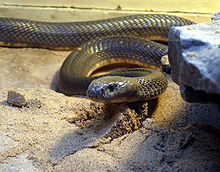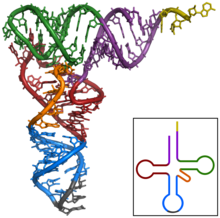
Ribonuclease V1 (RNase V1) is a ribonuclease enzyme found in the venom of the Caspian cobra (Naja oxiana). It cleaves double-stranded RNA in a non-sequence-specific manner, usually requiring a substrate of at least six stacked nucleotides. Like many ribonucleases, the enzyme requires the presence of magnesium ions for activity.
Laboratory use
Purified RNase V1 is a commonly used reagent in molecular biology experiments. In conjunction with other ribonucleases that cleave single-stranded RNA after specific nucleotides or sequences – such as RNase T1 and RNase I – it can be used to map internal interactions in large RNA molecules with complex secondary structure or to perform footprinting experiments on macromolecular complexes containing RNA.
RNase V1 is the only commonly used laboratory RNase that provides positive evidence for the presence of double-stranded helical conformations in target RNA. Because RNase V1 has some activity against RNA that is base-paired but single-stranded, dual susceptibility to both RNase V1 and RNase I at a single site in a target RNA molecule provides evidence of this relatively unusual conformation found in RNA loops.

Structural discoveries
RNase V1 played a particularly important role in the elucidation of the distinctive stem-loop structure of transfer RNA. It has also been extensively used to study the highly structured RNA genomes of retroviruses, such as hepatitis C, dengue virus, and HIV. Together with S1 nuclease, which specifically cleaves single-stranded RNA, it can be used to profile the secondary structure propensities of messenger RNA molecules, a procedure that can be applied to whole transcriptomes when paired with deep sequencing.
References
- ^ Favorova OO, Fasiolo F, Keith G, Vassilenko SK, Ebel JP (February 1981). "Partial digestion of tRNA--aminoacyl-tRNA synthetase complexes with cobra venom ribonuclease". Biochemistry. 20 (4): 1006–11. doi:10.1021/bi00507a055. PMID 7011369.
- Ying, Shao Yao, ed. (2006-01-01). MicroRNA Protocols. Humana Press. p. 23. ISBN 9781597451239.
- ^ Nilsen TW (April 2013). "RNA structure determination using nuclease digestion". Cold Spring Harbor Protocols. 2013 (4): 379–82. doi:10.1101/pdb.prot072330. PMID 23547152.
- Duval, Melodie; Romilly, Cedric; Helfer, Anne-Catherine; Fuchsbauer, Olivier; Romby, Pascale; Marzi, Stefano (2013). Klostermeier, Dagmar; Hammann, Christian (eds.). RNA Structure and Folding: Biophysical Techniques and Prediction Methods. Walter de Gruyter. p. 32. ISBN 9783110284959.
- Lowman HB, Draper DE (April 1986). "On the recognition of helical RNA by cobra venom V1 nuclease". The Journal of Biological Chemistry. 261 (12): 5396–403. doi:10.1016/S0021-9258(19)57229-5. PMID 2420800.
- Chaulk SG, Xu Z, Glover MJ, Fahlman RP (April 2014). "MicroRNA miR-92a-1 biogenesis and mRNA targeting is modulated by a tertiary contact within the miR-17~92 microRNA cluster". Nucleic Acids Research. 42 (8): 5234–44. doi:10.1093/nar/gku133. PMC 4005684. PMID 24520115.
- Lockard RE, Kumar A (October 1981). "Mapping tRNA structure in solution using double-strand-specific ribonuclease V1 from cobra venom". Nucleic Acids Research. 9 (19): 5125–40. doi:10.1093/nar/9.19.5125. PMC 327503. PMID 7031604.
- Blight KJ, Rice CM (October 1997). "Secondary structure determination of the conserved 98-base sequence at the 3' terminus of hepatitis C virus genome RNA". Journal of Virology. 71 (10): 7345–52. doi:10.1128/JVI.71.10.7345-7352.1997. PMC 192079. PMID 9311812.
- Polacek C, Foley JE, Harris E (January 2009). "Conformational changes in the solution structure of the dengue virus 5' end in the presence and absence of the 3' untranslated region". Journal of Virology. 83 (2): 1161–6. doi:10.1128/JVI.01362-08. PMC 2612390. PMID 19004957.
- Harrison GP, Lever AM (July 1992). "The human immunodeficiency virus type 1 packaging signal and major splice donor region have a conserved stable secondary structure". Journal of Virology. 66 (7): 4144–53. doi:10.1128/JVI.66.7.4144-4153.1992. PMC 241217. PMID 1602537..
- Kertesz M, Wan Y, Mazor E, Rinn JL, Nutter RC, Chang HY, Segal E (September 2010). "Genome-wide measurement of RNA secondary structure in yeast". Nature. 467 (7311): 103–7. Bibcode:2010Natur.467..103K. doi:10.1038/nature09322. PMC 3847670. PMID 20811459.
- Silverman, Ian M.; Berkowitz, Nathan D.; Gosai, Sager J.; Gregory, Brian D. (2016). "Genome-Wide Approaches for RNA Structure Probing". In Yeo, Gene W. (ed.). RNA Processing. Springer. pp. 29–59. ISBN 978-3-319-29071-3.